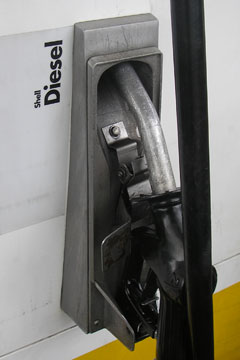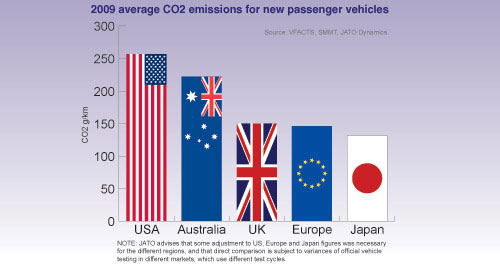News - General NewsLatest view on CO2Carbon control: Mandatory CO2 emissions limits are on the agenda for Australia. Local CO2 issue still up in the air as other markets decide to ‘step on the gas’17 Aug 2010 By TERRY MARTIN CARBON dioxide has captured the attention of politicians, car-makers and motorists throughout the world, and in Australia the levels of CO2 across the new-vehicle market, while not the biggest issue, is on the agenda as we run into a federal election this weekend. Providing it is returned to office, the Gillard government said it will consider a new – and, for the first time, mandatory – CO2 target of 190 grams per kilometre by 2015, reducing further to 155g/km in 2024. But by announcing the long-anticipated new targets as a policy during the election campaign, Labor has left itself room for negotiation with the local car industry. The final figures might not change much, but, as has happened in Europe, there could be allowances based on factors such as vehicle mass. In Europe, the EU is phasing in a 130g/km limit for passenger cars by 2012 – and has set a limit of 95g/km by 2020 – but the initial target for each manufacturer varies according to the average weight of their vehicles. That means that manufacturers of bigger cars, such as the prestige German brands, might only have to reach, say, 140g/km, while small-car specialists such as Fiat will not have the same luxury.  Among the criticisms levelled at this approach is that it discourages manufacturers from reducing vehicle mass and could even prompt some to build bigger and heavier cars to receive a less demanding CO2 target. Among the criticisms levelled at this approach is that it discourages manufacturers from reducing vehicle mass and could even prompt some to build bigger and heavier cars to receive a less demanding CO2 target.Also in Europe, generous scrappage schemes have had a discernible impact on reducing average CO2 levels in the short-term, with significant falls on the continent and in the UK. However, these were based on subsidies of around $5000 per car – much more than the $2000 rebate the Gillard government is offering with its proposed ‘cleaner car rebate’, which is also capped at $394 million. There is no word from Labor on how much impact its scheme will have on reducing Australia’s current average CO2 output for new vehicles of 218g/km. This figure is falling of its own accord via overseas regulations and from the world’s car-makers which have responded to the pressure from legislators and consumers. The federal government, of whatever political persuasion, could do much more to reduce the figure further but it will likely come at the expense of the local manufacturing industry. It could, for example, increase the scrappage bonus to genuinely stimulate sales of new budget cars, which are generally less polluting than used ones. It could offer incentives for green cars and, as an extension of this, make a genuine commitment to building an electric vehicle infrastructure and encourage a greater influx of ‘zero-emission’ cars to Australia. But as GoAuto revealed last week, increasing the number of imported cars – no matter how much cleaner they are than those built here – is something the current federal minister, Kim Carr, refuses to do. In his words: “We say that we can actually build capacity in Australia rather than develop the capacities of other people’s automotive industry.” There are no commitments to, but always the prospect that, the government of the day will take a lead role in boosting the uptake of alternative fuels, particularly LPG and CNG, while diesel tariffs could also be lowered to encourage clean diesel vehicle sales. While Australia’s CO2 figure is moving in the right direction, other countries are moving at a much faster rate. Based on figures from the Federal Chamber of Automotive Industries (FCAI), the UK’s Society of Motor Manufacturers and Traders (SMMT) and automotive data provider JATO Dynamics, the CO2 average for Australian passenger cars (excluding light commercial vehicles) last year was 221.9g/km – better than the massive US market, which averaged 256.6g, but well behind the UK (149.5g), Europe (145.9g, taken across 21 countries) and Japan (131.2g). According to JATO, the total US light vehicle market also improved 1.0g in the first quarter of 2010 to 268.5g/km. To compare more closely with Europe, JATO also excluded pick-up trucks, full-size vans and small commercial vehicles, which brought the figure back to 255.6g/km. By comparison, JATO said Japan was at 130g/km at the end of the first quarter (down 0.4g), while Europe’s five biggest markets averaged 140.3g/km (down 4.3g/km). In the UK, first-half figures recently released by the SMMT show the average CO2 figure has fallen 4.7 per cent to 145g/km compared to the same period in 2009. Registrations of alternative fuel cars in the UK – plus cars signposted as eco models (BlueMotion, BlueEfficiency, Ecoflex, etc) – more than doubled over the period (to 11,468 units), and while there is some concern that the rate of improvement will slow with a scrappage scheme no longer operating, the SMMT said new technologies constantly emerging should maintain the positive trend. Across Europe, JATO says diesel’s market share is at 48.9 per cent, while in the US it is 1.7 per cent. Japan has no taste for diesel, at 0.11 per cent, while the latest Australian VFACTS figures show that Australia’s diesel light vehicle share, over the first seven months, is now up to 25.4 per cent. Interestingly, JATO figures also show that US consumers are much more inclined than Europeans to take up hybrid technology, with hybrids having a 2.3 per cent market share in the US compared to 0.5 per cent in Europe. Japan leads the way with hybrids commanding a 10.1 per hybrid share, while YTD in Australia that figure, according to VFACTS, is just 0.9 per cent. Back in the US, the EPA and NHTSA are set to introduce the first-ever national greenhouse gas emissions standards under the Clean Air Act, which will run alongside the new Corporate Average Fuel Economy (CAFE) standards. With these, a new combined average CO2 level of 250g per mile will apply from the model year 2012 for passenger cars, light trucks and medium-duty passenger vehicles.  Read more10th of August 2010  More local hybrids, EVs in pipelineKim Carr sees new Australian-built hybrids, EVs on sale inside five years3rd of August 2010  Rumblings on ‘clunkers’ moveMany in auto industry question effectiveness of $2000 bounty on old trade-ins27th of July 2010  Gillard promises cash for clunkers$394 million pledged to rid Aussie roads of inefficient pre-1995 cars |
Click to shareGeneral News articlesResearch General News Motor industry news |
















Facebook Twitter Instagram